![]()
![]()
![]()
Use LEFT and RIGHT arrow keys to navigate between flashcards;
Use UP and DOWN arrow keys to flip the card;
H to show hint;
A reads text to speech;
54 Cards in this Set
- Front
- Back
- 3rd side (hint)
|
What is the relative impact of fungal pathogens?
|
over 10,000 fungal species cause plant diseases vs 50 for man and animals
|
|
|
|
What kingdoms are Eukaryota vs Prokaryota?
|
Eukaryota--Plantae, Animalia, Fungi, Chromista, Protozoa
Prokaryota--Archaea, Bacteria |
|
|
|
Compare animals, plants and fungi.
|
Animals-heterotrophic, no chloroplasts, with no cell wall
Plants--autotrophic, has chloroplasts, cell wall made of cellulose and lignin Fungi--heterotrophic, no chloroplasts, cell wall made of chitin, glucans, or cellulose |
|
|
|
What is the fungal nomenclature?
|
Phylum--mycota
Class--mycetes Order--ales Family--aceae |
|
|
|
Compare Protozoa, Chromista and Fungi.
|
Protozoa are phagotrophic, unicellular biotrophs; Chromista are multicellular with cell walls of glucan and cellulose that are coenocytic with biflagellate zoospores and oospores
|
|
|
|
Compare Eukaryota and Prokaryota.
|
Eukaryota have a nucleus and prokaryota lack an organized nucleus
|
|
|
|
What is a saprophyte?
|
lives only on dead organic matter
|
|
|
|
What is a biotroph (obligate parasite)?
|
grow and multiply only by remaining, during their entire life, in association with their host
|
|
|
|
What is a hemibiotroph?
|
pass part of their lives on the host as parasites and part on dead tissues of the same host as saprophytes in order to complete their life cycle
|
|
|
|
What is a facultative saprophyte?
|
grow parasitically on the host aand live, grow and multiply on dead tissues of the host after its death
|
|
|
|
What is a facultative parasite?
|
live in soil as saprophytes but under right environmental conditions may parasitize the plant
|
|
|
|
What is mycellium/mycelia?
|
filamentous vegetative body that branches out in all directions
|
|
|
|
What is hyphae?
|
the individual branches of the mycellium
|
|
|
|
What is conidia/condium?
|
reproductive structures (spores)
|
|
|
|
What is sclerotia?
|

a vegetative resting body of a fungus, composed of a compact mass of hyphae with or without host tissue, usually with a darkened rind,
seen in R. solani and S. rolfsi both in Basidiomycota |
|
|
|
What is a chlamydospore?
|
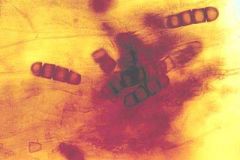
thick-walled or double-walled asexual resting spore formed from hyphal cells (terminal or intercalary) or by transformation of conidial cells that can function as an overwintering stage, occurs in Fusarium spp (Ascomycota)
|
|
|
|
What is a zoospore?
|
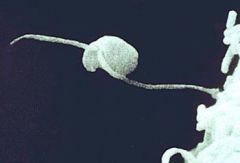
fungal spore with flagella, capable of locomotion in water, in Chytridiomycota
|
|
|
|
What is a conidiophore?
|
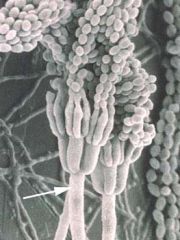
simple or branched hypha on which conidia are produced, in Zygomycota
|
|
|
|
What is sporangium/sporangia?
|

saclike fungal structure in which the entire contents are converted into an indefinite number of asexual spores, in Zygomycota
|
|
|
|
What is a spordochium?
|
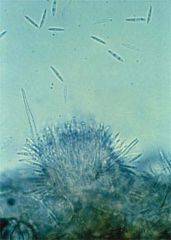
superficial, cushion-shaped asexual fruiting body consisting of a cluster of conidiophores, in Fusarium
|
conidial development
|
|
|
What is a pycnidium?
|
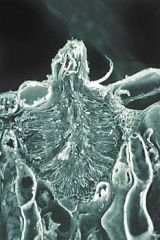
asexual, globose or flask-shaped fruiting body of certan imperfect fungi producing conidia, in Deuteromycota
|
conidial development
|
|
|
What is an acervulus?
|
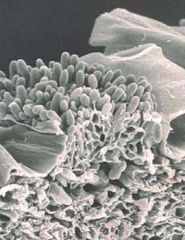
erumpent, cushionlike fruiting body bearing conidiophores, conidia, and sometimes setae
|
conidial development
|
|
|
What is a synnema?
|
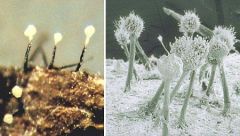
a group of erect, sometimes fused conidiophores that produce conidia at or near the apex
|
conidial development
|
|
|
What is a phialide?
|
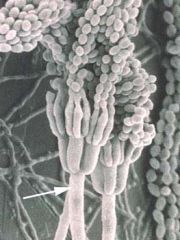
end ceall of a conidiophore with one or more open ends through whicch a basipetal succession of conidia develops
|
conidial development
|
|
|
What is a crozier?
|

the hook of an ascogenous hypha before ascus development
|
in Ascomycota
|
|
|
What is an ascus/asci?
|
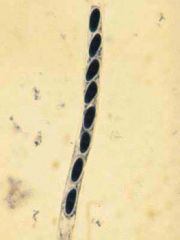
saclike structure containing ascospores (typically eight) and usually borne in a fungal fruiting body
|
in Ascomycota
|
|
|
What is a perithecium/peritheica?
|

flask-shaped or subglobose, thin-walled fungus fruiting body (ascocarp) containing asci and ascospores; spores are expelled or released through a pore (ostiole) at the apex
|
in Ascomycota
|
|
|
What is a cleisothecium/cleistothecia?
|
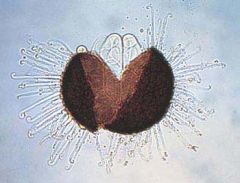
a spherical ascocarp that is closed at maturity
|
in Ascomycota
|
|
|
What is an apothecium/apothecia?
|
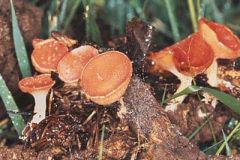
open, cuplike or saucerlike, ascus-bearing fungal fruiting body (ascocarp), often supported on a stalk
|
|
|
|
What is basidium/basidia?
|

specialized cell or organ, often club-shaped, in which karyogamy and meiosis occur, followed by production of externally-borne basidiospores (generally four) that are haploid.
|
|
|
|
What is an apothecium/apothecia?
|
open, cuplike or saucerlike, ascus-bearing fungal fruiting body (ascocarp), often supported on a stalk
|
|
|
|
What is an ascospore?
|
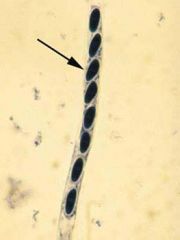
sexual spore borne in an ascus
|
|
|
|
What is a basidiospore?
|
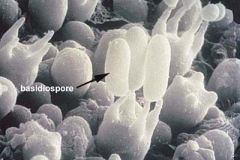
haploid (1N) sexual spore produced on a basidium
|
|
|
|
What is a zygospore
|
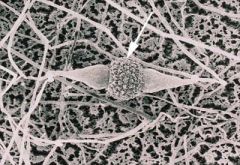
sexual resting spore formed from the union of gametangia in the Zygomycetes
|
|
|
|
What does it mean to be dikaryotic?
|
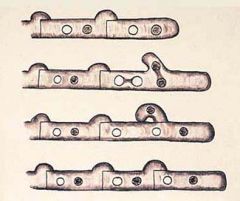
having two sexually compatible haploid nuclei per cell, that divide simultaneously; this phase is called the dikaryophase
|
|
|
|
What is haploid?
|
having a single complete set of chromosomes
|
|
|
|
What is diploid?
|
having two complete sets of chromosomes (2N chromosomes)
|
|
|
|
What is plasmogamy?
|
the fusion of two sex cells
|
|
|
|
What is karyogamy?
|
the fusion of nuclei
|
|
|
|
What is the anamorphic stage?
|
the asexual form in the life cycle of a fungus, when asexual spores (such as conidia) or no spores are produced
|
|
|
|
What is the teleomorphic stage?
|
the sexual form in the life cycle of a fungus
|
|
|
|
What is the holomorphic stage?
|
the whole fungus in all its states, anamorphic + teleomorphic
|
|
|
|
What is mitosporic fungi?
|
(syn. Fungi Imperfecti, deuteromycetes) group of fungi without a sexual stage; also, the asexual stage of ascomycetes and basidiomycetes
|
|
|
|
What is a fungi?
|
a eukaryotic organism that is usually filamentous (forming a mycelium) and heterotrophic, has cell walls composed of chitin, and reproduces by sexual and/or asexual spores
|
|
|
|
What does Forma specialis (f.sp) refer to in a species name?
|
a taxonomic group within a pathogenic species defined in terms of host range, i.e. members of different formae speciales infect different groups of plants
|
|
|
|
What does Race refer to in a species name?
|
subgroup or biotype within a species or variety, distinguished from other races by virulence, symptom expression, or host range, but not by morphology
|
|
|
|
What are the characteristics for Chytridiomycota?
|
1) Water or soil inhabiting
2) Produce zoosporangia and zoospores 3) Survive in soil as resting spors |
|
|
|
What are the characteristics for Zygomycota?
|
1) Weak or opportunistic plant pathogens
2) Associated with post harvest diseases 3) Sexual reprod is by two morphologically similar gametangia 4) Zygospore results and is the resting structure 5) Secretes enzymes that diffuse into living tissue, dirupt and kill cells 6) Has coenocytic mycelium |
|
|
|
What are the characteristics for Ascomycota?
|
1) Produce haploid mycelium
2) Produce conidia in conidophores or fruiting bodies 3) Sexual spores-ascospores |
|
|
|
What are the characteristics for Basidiomycota?
|
1) Most advanced of the plant pathogenic fungi
2) Includes mushrooms, shelf fungi, puffballs 3) Rust and Smuts 4) Form clamp connections 5) Sexual spores-basidospores |
|
|
|
What are 2 examples of diseases caused by Ascomycota?
|
Powdery mildew-an obligate parasite
Mango Anthracnose |
|
|
|
What are some characteristics of rusts?
|
in Basidiomycota
They are specialized parasites that only attach certain genera of plants Can be autoecious (complete lige on single host) or heteroecious (life cycle on two different or alternate host) Rusts are morphologically identical but attack different hosts (f. sp.) Can have races |
|
|
|
What are some characteristics of smut?
|
in Basidomycota
Attacks the ovaries of grains and grasses and develop in them-kernels Haploid mycelium cannot invade tissue extensively, does not cause typical infections until tow compatible mycelia unite to produce dikaryotic mycelium Can have races Overwinter as teliospores ie: Karnal Bunt of Wheat |
|
|
|
How are fungi spread?
|
zoospores-motile, hyphal growth, wind, water, birds, insects, animals, humans, spores or hyphal fragments
|
|

